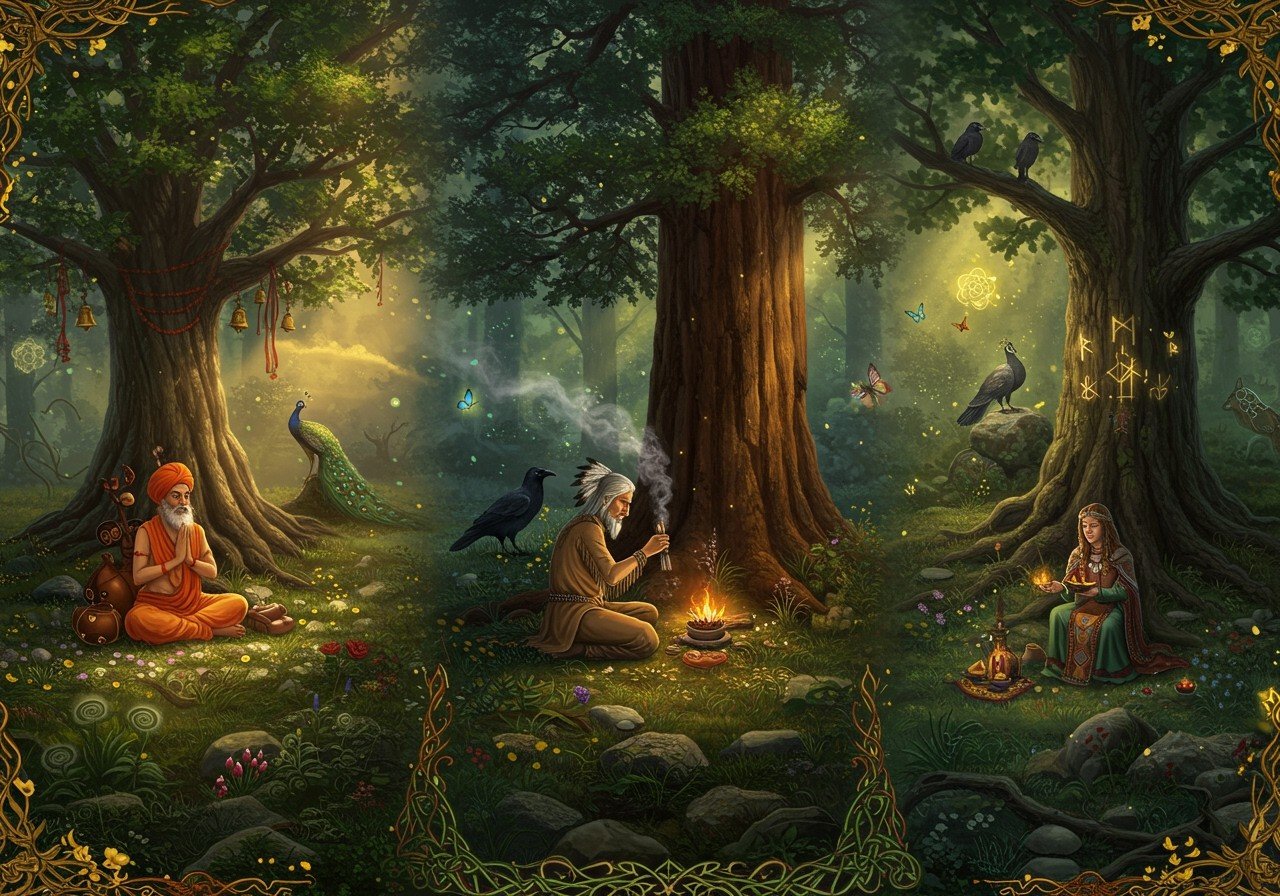
Nature worship, the reverence for the natural world as sacred, is a practice woven into the tapestry of many cultures. From ancient rituals to modern expressions, the honoring of nature’s divinity takes diverse forms. This exploration delves into how different cultures, including Japanese and Celtic traditions, express their reverence, providing insights into cultural identities and the enduring legacy of nature worship.
Nature Worship in Japan: The Way of Shinto
Shinto, the indigenous spiritual tradition of Japan, is deeply rooted in nature worship. Central to Shinto is the concept of Kami, spirits believed to reside in natural elements like mountains, rivers, trees, and even rocks. Shinto rituals and ceremonies are performed to honor these Kami and maintain a harmonious relationship with the natural world. Sacred sites, often shrines nestled within natural settings, play a crucial role in Japanese spiritual life, offering spaces for communion with the divine.
Nature’s influence permeates Japanese arts, from the delicate arrangements of ikebana (flower arranging) to the meticulous cultivation of bonsai (miniature trees), reflecting a deep appreciation for the aesthetics of the natural world. Seasonal festivals, like Hanami, the celebration of cherry blossoms, further demonstrate the Japanese reverence for nature’s beauty and cyclical rhythms.
Poojn.in offers a variety of items perfect for creating a serene atmosphere for meditation and reflection, enhancing your connection with nature. Explore our collection of camphor and incense to create a sacred space in your home.
Celtic Nature Worship: Reverence for the Earth
Celtic nature worship is characterized by a profound reverence for natural landscapes and the elements. Sacred groves, particularly those featuring oak trees, hold special significance in Celtic spirituality, serving as places of worship and connection with the divine. Druids, the priestly class in Celtic society, acted as intermediaries between the human and spirit worlds, deeply attuned to the rhythms and wisdom of nature.
Seasonal festivals, such as Beltane and Samhain, mark key points in the agricultural cycle and the turning of the seasons, reflecting the Celtic people’s close relationship with the land. Celtic mythology is rich with deities associated with nature, like Cernunnos, the horned god of the wild, further demonstrating the deep integration of nature into their spiritual beliefs. This tradition has left an indelible mark on Celtic art, music, and literature, and its influence can be seen in modern neo-pagan practices.
Nature Worship Across Cultures: A Global Perspective
The reverence for nature is not confined to Japan and Celtic traditions; it resonates across cultures worldwide. Many indigenous tribes in Africa, the Americas, and Oceania hold animistic beliefs, viewing nature as a living entity imbued with spiritual power. In Hinduism, rivers like the Ganges and mountains are revered as sacred, and deities like Shiva and Durga embody the forces of nature. These diverse expressions of nature worship underscore the interconnectedness of all living beings and the importance of respecting the delicate balance of the natural world.
Poojn.in recognizes the significance of these diverse traditions. Explore our collection of Lord Shiva murtis and other sacred items to enhance your personal practice.
Modern Relevance and the Revival of Nature Worship
In today’s world, ancient nature worship practices hold renewed relevance. They offer valuable lessons in environmental conservation and awareness, reminding us of the interconnectedness of all life. Reviving traditional festivals and rituals provides opportunities to reconnect with cultural heritage and deepen our understanding of our place within the natural world.
Nature worship offers a holistic approach to well-being, promoting mental and spiritual health in increasingly urbanized societies. Its influence can be seen in contemporary art, literature, and popular culture, reflecting a growing desire to reconnect with the natural world. Eco-spirituality movements, inspired by nature worship, align with environmental activism, fostering a sense of global community and shared responsibility for the planet.
Nature Worship’s Core Characteristics
Nature worship is characterized by a set of core principles that celebrate the sacredness of the natural world and acknowledge the presence of divinity within nature. These characteristics include:
Sacredness of Nature
Nature religions view all aspects of nature, from the smallest creatures to the largest mountains, as sacred or divine. This belief emphasizes respect and honor for the entire natural world.
Plurality of Deities
Many nature-based traditions embrace polytheism, believing in multiple deities often associated with specific natural elements like rivers, mountains, or celestial bodies.
Interconnectedness and Egalitarianism
Nature worship underscores the interconnectedness of all things in the universe, recognizing a web of energy or life-force that binds all of creation together. These traditions often promote egalitarianism, minimizing hierarchical structures within their communities.
Sacred Spaces and Resistance to Institutionalization
Sacred spaces in nature religions are typically found in natural environments, with ceremonies and rituals often taking place outdoors. These traditions often resist the formation of large, formalized institutions, preferring to maintain a direct connection with the natural world.
Examples of Nature Religions
Nature worship manifests in various forms across different cultures and historical periods. Some prominent examples include:
Animism and Shamanism
Animism, the belief that all living things possess a unique spiritual essence, is prevalent in many indigenous cultures. Shamanism, often intertwined with animistic beliefs, focuses on the well-being of nature and may involve rituals to interact with or influence natural elements.
Paganism and Wicca
Paganism encompasses a broad range of polytheistic, nature-based religions, with modern Pagan faiths flourishing in Europe and North America. Wicca, a specific form of modern Paganism, centers on the concept of an earth mother goddess and incorporates ritual magic.
Shinto and Druidism
Shinto, the indigenous tradition of Japan, honors Kami, spirits that inhabit natural elements. Druidism, associated with Celtic cultures, equates divinity with the natural world, emphasizing a deep connection with trees, groves, and other natural sites.
Elements of Nature Worship
Several key elements characterize nature worship practices:
Deification of Natural Forces
Gods and goddesses in nature religions often represent natural forces like fire, rain, thunderstorms, and the changing seasons, embodying the power and dynamism of nature.
Veneration of the Earth Mother
The Earth Mother, a symbol of fertility, abundance, and the nurturing aspects of nature, is a central figure in many nature worship traditions.
Totemism and Solar/Lunar Deities
Totemism, the belief in a mystical relationship between humans and specific animals or natural objects, is another common element. Solar and lunar deities, personifying the sun and moon, often play significant roles in nature-based mythologies and rituals.
FAQs About Nature Worship Across Cultures: A Global Exploration
What is nature worship? Nature worship encompasses a wide range of spiritual practices and beliefs centered on the reverence for the natural world. These practices often involve rituals, ceremonies, and a deep respect for natural elements like trees, rivers, mountains, and celestial bodies.
How is nature worship practiced in Japan? In Japan, Shinto traditions embody nature worship through the veneration of Kami, spirits believed to inhabit natural objects and phenomena. Shinto rituals and festivals, often held at shrines in natural settings, honor these spirits and maintain harmony with the natural world.
What are some examples of Japanese nature worship? Examples include rituals like the Toshigoi no Matsuri, a festival praying for a good harvest, and the reverence for sacred mountains like Mount Fuji. These practices reflect a deep connection between the Japanese people and their natural environment.
How do Celtic traditions incorporate nature worship? Celtic nature worship emphasizes the spiritual significance of natural sites such as groves, rivers, and hills. Seasonal festivals like Beltane and Samhain mark important points in the agricultural cycle and demonstrate the Celtic people’s close relationship with the land and its rhythms.
Why do cultures practice nature worship? Cultures practice nature worship for a variety of reasons, including expressing gratitude for nature’s gifts, seeking blessings from natural forces, and maintaining a harmonious relationship with the environment. It often reflects a deep spiritual connection and a recognition of the interconnectedness of all life.
Are there similarities between nature worship in different cultures? Yes, despite cultural variations, many nature worship traditions share common threads, such as the reverence for sacred trees, the practice of conducting rituals at natural sites, and the celebration of seasonal changes. These similarities highlight a universal respect for nature’s power and beauty.
Is nature worship still practiced today? Nature worship continues to be practiced in many cultures around the world, both in traditional forms and through contemporary revivals. Modern movements like neo-paganism draw inspiration from ancient nature-based practices, demonstrating the enduring appeal of connecting with the natural world.
How does nature worship influence cultural practices? Nature worship profoundly influences cultural practices by shaping festivals, rituals, artistic expressions, and daily life. It instills values of environmental stewardship, respect for natural resources, and a recognition of humanity’s place within the larger web of life.
Conclusion: Embracing Nature’s Wisdom
Nature worship, in its diverse forms, serves as a powerful reminder of the sacred bond between humanity and the earth. It teaches us to approach the natural world with respect, gratitude, and a deep appreciation for its inherent wisdom. By recognizing the divinity within nature, we embrace a worldview that values interconnectedness, harmony, and the responsibility to protect our planet.


